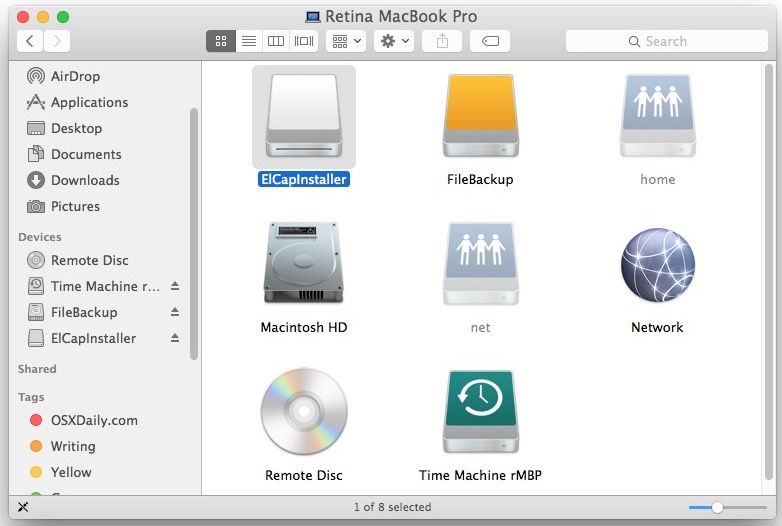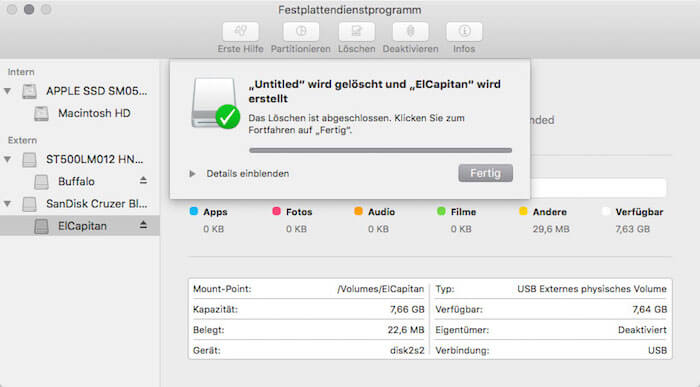- El Capitan Createinstallmedia Free
- Macos El Capitan Createinstallmedia
- El Capitan Createinstallmedia Download
/Applications/Install OS X El Capitan.app/Contents/Resources/createinstallmedia --volume /Volumes/mavinstall --applicationpath /Applications/Install OS X El Capitan.app --nointeractionNov 23, 2019 A lot of macOS installer apps downloaded before Oct 2019/Nov 2019 contain an outdated certification chain and thus are invalid. Simply download a new OS X El Capitan install.dmg (with a valid cert chain this time), open the dmg and open the InstallOS.pkg. The installer package installs the 'Install OS X El Capitan.app' in the Applications folder. Jun 10, 2021 My Macs are all running Big Sur, but i've an 2012 MacBook Pro lying around that i would love to reinstall with El Capitan or some other OSX to give it to my daughter. But how could i get the createInstallMedia tool on one of my Big Sur machines, to create that installation media for ElCapitan?
Note: You’ll need to elevate your privileges for this to run. Once run you’ll see that it erases the disk, copies the Installation materials (InstallESX, etc) and then makes the drive bootable, as follows:Erasing Disk: 0%... 10%... 20%... 100%... Copying installer files to disk... Copy complete. Making disk bootable... Copying boot files... Copy complete. Then you can either select the new volume in the Startup Disk System Preference pane or boot the computer holding down the option key to select the new volume. Note: If you can do this on a system with a solid state drive it will be faster. Although this took 17 minutes last I ran it even then so be patient for the files to copy.
- Download: OS X El Capitan This downloads as a disk image named InstallMacOSX.dmg. On a Mac that is compatible with El Capitan, open the disk image and run the installer within, named InstallMacOSX.pkg. It installs an app named Install OS X El Capitan into your Applications folder.
- Open the disk image, then open the.pkg installer inside the disk image. It installs an app named Install Version Name. Open that app from your Applications folder to start installing the operating system. MacOS Sierra 10.12 can upgrade El Capitan, Yosemite, Mavericks, Mountain Lion or Lion.
These advanced steps are primarily for system administrators and others who are familiar with the command line. You don't need a bootable installer to upgrade macOS or reinstall macOS, but it can be useful when you want to install on multiple computers without downloading the installer each time.
As long as I erased my Mac and 'bootable usb El Capitan install drive' installation process complained with verification problem I decided to reinstall 'Yosemite' using the built-in recovery disk, then I downloaded installer for 'El Capitan' from 'App Store'.
What you need to create a bootable installer
- A USB flash drive or other secondary volume formatted as Mac OS Extended, with at least 14GB of available storage
- A downloaded installer for macOS Big Sur, Catalina, Mojave, High Sierra, or El Capitan
Download macOS
- Download: macOS Big Sur, macOS Catalina, macOS Mojave, or macOS High Sierra
These download to your Applications folder as an app named Install macOS [version name]. If the installer opens after downloading, quit it without continuing installation. To get the correct installer, download from a Mac that is using macOS Sierra 10.12.5 or later, or El Capitan 10.11.6. Enterprise administrators, please download from Apple, not a locally hosted software-update server. - Download: OS X El Capitan
This downloads as a disk image named InstallMacOSX.dmg. On a Mac that is compatible with El Capitan, open the disk image and run the installer within, named InstallMacOSX.pkg. It installs an app named Install OS X El Capitan into your Applications folder. You will create the bootable installer from this app, not from the disk image or .pkg installer.
Use the 'createinstallmedia' command in Terminal
- Connect the USB flash drive or other volume that you're using for the bootable installer.
- Open Terminal, which is in the Utilities folder of your Applications folder.
- Type or paste one of the following commands in Terminal. These assume that the installer is in your Applications folder, and MyVolume is the name of the USB flash drive or other volume you're using. If it has a different name, replace
MyVolumein these commands with the name of your volume.
Big Sur:*
Catalina:*
Mojave:*
High Sierra:*
El Capitan:
* If your Mac is using macOS Sierra or earlier, include the --applicationpath argument and installer path, similar to the way this is done in the command for El Capitan.
After typing the command:
- Press Return to enter the command.
- When prompted, type your administrator password and press Return again. Terminal doesn't show any characters as you type your password.
- When prompted, type
Yto confirm that you want to erase the volume, then press Return. Terminal shows the progress as the volume is erased. - After the volume is erased, you may see an alert that Terminal would like to access files on a removable volume. Click OK to allow the copy to proceed.
- When Terminal says that it's done, the volume will have the same name as the installer you downloaded, such as Install macOS Big Sur. You can now quit Terminal and eject the volume.
Use the bootable installer
El Capitan Createinstallmedia Free
Determine whether you're using a Mac with Apple silicon, then follow the appropriate steps:
Macos El Capitan Installer App
Apple silicon
- Plug the bootable installer into a Mac that is connected to the internet and compatible with the version of macOS you're installing.
- Turn on your Mac and continue to hold the power button until you see the startup options window, which shows your bootable volumes and a gear icon labled Options.
- Select the volume containing the bootable installer, then click Continue.
- When the macOS installer opens, follow the onscreen instructions.

Intel processor
- Plug the bootable installer into a Mac that is connected to the internet and compatible with the version of macOS you're installing.
- Press and hold the Option (Alt) ⌥ key immediately after turning on or restarting your Mac.
- Release the Option key when you see a dark screen showing your bootable volumes.
- Select the volume containing the bootable installer. Then click the up arrow or press Return.
If you can't start up from the bootable installer, make sure that the External Boot setting in Startup Security Utility is set to allow booting from external media. - Choose your language, if prompted.
- Select Install macOS (or Install OS X) from the Utilities window, then click Continue and follow the onscreen instructions.
Learn more
Macos El Capitan Createinstallmedia
El Capitan Usb Installer App
For more information about the createinstallmedia command and the arguments that you can use with it, make sure that the macOS installer is in your Applications folder, then enter the appropriate path in Terminal:
- Big Sur: /Applications/Install macOS Big Sur.app/Contents/Resources/createinstallmedia
- Catalina: /Applications/Install macOS Catalina.app/Contents/Resources/createinstallmedia
- Mojave: /Applications/Install macOS Mojave.app/Contents/Resources/createinstallmedia
- High Sierra: /Applications/Install macOS High Sierra.app/Contents/Resources/createinstallmedia
- El Capitan: /Applications/Install OS X El Capitan.app/Contents/Resources/createinstallmedia
El Capitan Installer App
El Capitan Createinstallmedia Download
Photoshop cs3 mac ita download. A bootable installer doesn't download macOS from the internet, but it does require an internet connection to get firmware and other information specific to the Mac model.